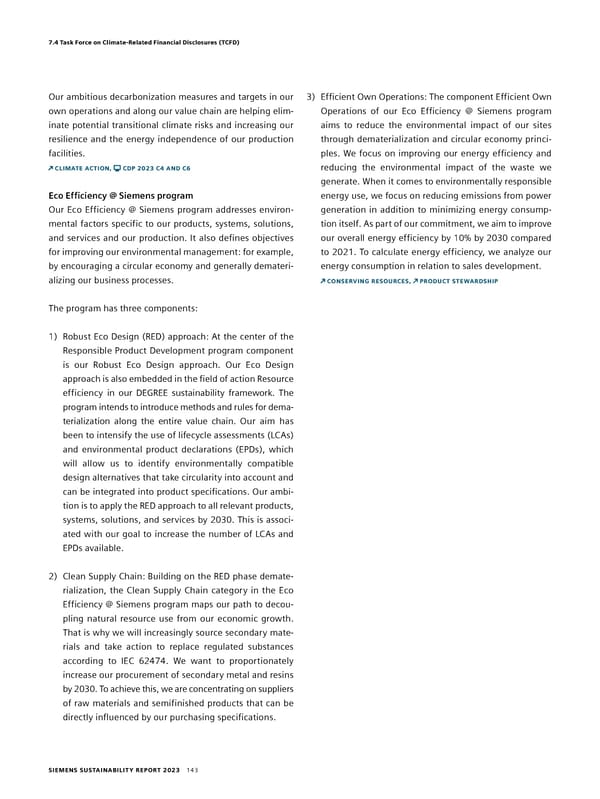7.4 Task Force on ClimateRelated Financial Disclosures (TCFD) Our ambitious decarbonization measures and targets in our 3) Efficient Own Operations: The component Efficient Own own operations and along our value chain are helping elim- Operations of our Eco Efficiency @ Siemens program inate potential transitional climate risks and increasing our aims to reduce the environmental impact of our sites resilience and the energy independence of our production through dematerialization and circular economy princi- facilities. ples. We focus on improving our energy efficiency and CLIMATE ACTION, CDP 2023 C4 AND C6 reducing the environmental impact of the waste we generate. When it comes to environmentally responsible Eco Efficiency @ Siemens program energy use, we focus on reducing emissions from power Our Eco Efficiency @ Siemens program addresses environ- generation in addition to minimizing energy consump- mental factors specific to our products, systems, solutions, tion itself. As part of our commitment, we aim to improve and services and our production. It also defines objectives our overall energy efficiency by 10% by 2030 compared for improving our environmental management: for example, to 2021. To calculate energy efficiency, we analyze our by encouraging a circular economy and generally demateri- energy consumption in relation to sales development. alizing our business processes. CONSERVING RESOURCES, PRODUCT STEWARDSHIP The program has three components: 1) Robust Eco Design (RED) approach: At the center of the Responsible Product Development program component is our Robust Eco Design approach. Our Eco Design approach is also embedded in the field of action Resource efficiency in our DEGREE sustainability framework. The program intends to introduce methods and rules for dema- terialization along the entire value chain. Our aim has been to intensify the use of lifecycle assessments (LCAs) and environmental product declarations (EPDs), which will allow us to identify environmentally compatible design alternatives that take circularity into account and can be integrated into product specifications. Our ambi- tion is to apply the RED approach to all relevant products, systems, solutions, and services by 2030. This is associ- ated with our goal to increase the number of LCAs and EPDs available. 2) Clean Supply Chain: Building on the RED phase demate- rialization, the Clean Supply Chain category in the Eco Efficiency @ Siemens program maps our path to decou- pling natural resource use from our economic growth. That is why we will increasingly source secondary mate- rials and take action to replace regulated substances according to IEC 62474. We want to proportionately increase our procurement of secondary metal and resins by 2030. To achieve this, we are concentrating on suppliers of raw materials and semifinished products that can be directly influenced by our purchasing specifications. SIEMENS SUSTAINABILITY REPORT 2023 143
 Sustainability Report Page 142 Page 144
Sustainability Report Page 142 Page 144